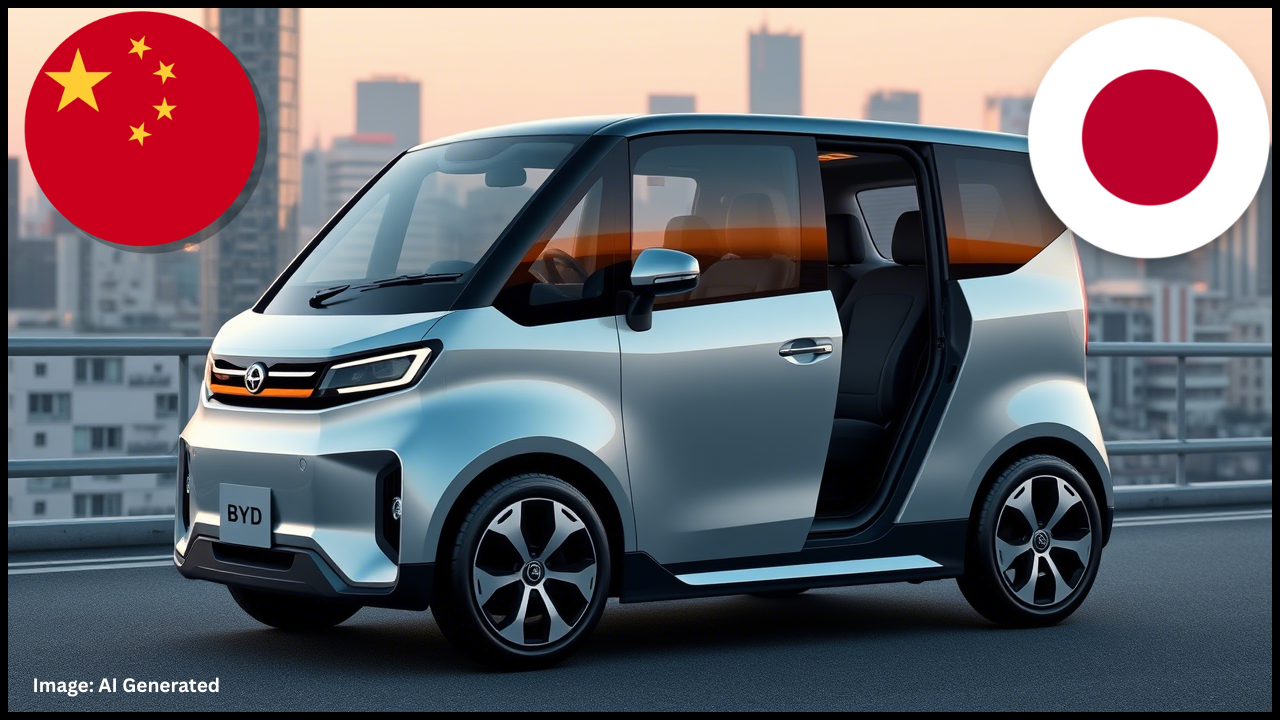China’s BYD is preparing to enter Japan’s highly specialized and competitive kei car market with a fresh lineup of ultra-compact electric vehicles (EVs). Scheduled for release in the second half of 2026, BYD’s new kei cars are designed to compete directly with Japan’s domestic giants such as Toyota, Honda, and Nissan by offering a unique blend of affordability, practicality, and electric efficiency. Inspired by the famous “Mr. Bean” style mini car, these vehicles aim to capture the hearts of urban and rural drivers alike, providing a viable alternative in a market segment valued at approximately $18 billion annually.
This article offers a deep dive into BYD’s strategy for Japan, the challenges it faces, and the broader implications for the global EV market. Written to be accessible for a general audience yet informative enough for industry professionals, this comprehensive overview explains the kei car phenomenon, BYD’s approach, and practical advice for consumers and investors interested in this space.
Quick Summary
- BYD targets Japan’s $18 billion kei car market by launching affordable electric minicars in late 2026.
- The kei car segment accounts for about 40% of Japan’s total auto sales, dominated by Toyota, Honda, and Nissan.
- BYD plans to price its new EVs below ¥2.6 million (~$17,500), focusing on cost-conscious buyers.
- Japan’s EV adoption remains low, with only around 1% of 2024 vehicle sales being electric.
- BYD aims to expand its dealership network in Japan from 51 to 100 locations by the end of 2025.
- The success of BYD’s kei car in Japan could influence EV trends in other regions such as India and Europe.
What Are Kei Cars? Understanding the Japanese Market Context
To fully grasp BYD’s ambitious plan, it’s important to understand what makes kei cars so significant in Japan.
Kei cars, short for kei jidōsha (軽自動車), are ultra-compact vehicles subject to specific regulations, including:
- Maximum engine displacement of 660cc
- Limited size dimensions (usually under 3.4 meters long, 1.48 meters wide, and 2 meters tall)
- Weight restrictions that make them lighter than standard cars
These parameters were established to create affordable, practical vehicles optimized for Japan’s dense urban areas and narrow streets. Kei cars come with substantial benefits, such as lower taxes, reduced insurance premiums, and easier parking regulations, making them especially popular among city dwellers and budget-conscious consumers.
The kei car market is estimated to be worth around $18 billion annually, representing nearly 40% of Japan’s new car sales. This dominance makes it one of the most important and fiercely competitive automotive segments in the country.
Japanese automakers like Toyota, Honda, Suzuki, and Nissan have historically led this market by crafting vehicles tailored to local tastes and driving habits. BYD’s plan to enter this space is a clear challenge to this status quo, aiming to disrupt with an all-electric option that aligns with global trends toward sustainability.
BYD’s Mr. Bean-Style Mini EV: What to Expect
BYD’s new kei car will embrace the quirky and compact style reminiscent of the classic “Mr. Bean” car—a small, boxy, and practical vehicle that is easy to maneuver through crowded city streets. This nostalgic design is combined with modern electric technology to offer something both familiar and innovative.
Pricing Strategy and Features
- Price point: The vehicle is expected to retail for less than ¥2.6 million (approximately $17,500 USD), positioning it competitively against current kei EVs such as Nissan’s Sakura, which sells for around ¥2.7 million. This pricing is essential to attract budget-minded consumers and those in rural areas where gasoline stations are becoming scarcer.
- Powertrain: Instead of engineering a complex, Japan-specific electric motor, BYD will use standardized EV batteries and motors that have been proven in other markets. This approach reduces production costs and shortens development time, allowing BYD to bring the vehicle to market faster.
- Design: The EV will prioritize compactness, maneuverability, and practical interior space, catering to urban commuters, small families, and elderly drivers who value simplicity and reliability.
Practical Benefits
The move to electric will offer several advantages:
- Lower running costs compared to gasoline cars
- Zero tailpipe emissions, contributing to Japan’s carbon reduction goals
- Quieter operation for improved urban living conditions
- Compatibility with Japan’s expanding charging infrastructure
BYD hopes this combination of affordability, convenience, and environmental friendliness will resonate with Japanese consumers as fuel prices rise and environmental awareness grows.
Challenges Facing BYD in Japan’s Market
Despite BYD’s strong position as the world’s top-selling EV manufacturer, the Japanese market poses unique difficulties.
Low EV Adoption Rate
Japan’s EV market remains underdeveloped. In 2024, only about 1% of all new vehicles sold were electric. This is significantly lower than in China, Europe, and the U.S., where EV penetration is rising rapidly. Japanese consumers are generally cautious about new technology, especially from foreign brands, and show a strong preference for domestic automakers.
Domestic Brand Loyalty and Trust
Brands like Toyota, Honda, and Nissan enjoy deep-rooted loyalty thanks to decades of reliability, quality, and tailored customer experiences. BYD, despite its global reputation, is relatively unknown in Japan and must overcome skepticism regarding product quality and service.
Government Policy and Subsidies
Recent adjustments to Japanese EV subsidies have favored local automakers, creating a tougher environment for foreign entrants. While subsidies still exist, they are less generous for imported vehicles, placing BYD at a disadvantage compared to homegrown competitors.
BYD’s Strategy to Overcome Market Hurdles
To increase its chances of success, BYD is implementing a multi-pronged approach:
Expanding Dealership and Service Network
BYD plans to nearly double its dealership count from 51 to 100 by the end of 2025. This expansion aims to boost brand visibility and ensure customers have convenient access to showrooms and after-sales support, which is critical in gaining consumer trust in Japan.
Competitive Pricing and Simplification
By using standardized components and efficient production methods, BYD can offer its kei cars at a price point that undercuts many domestic competitors. This focus on affordability is key in attracting price-sensitive buyers.
Emphasizing Reliability and Warranty
BYD is expected to back its vehicles with solid warranty packages and service plans that rival those of Japanese automakers, helping alleviate concerns over vehicle longevity and maintenance costs.
Educating Consumers
BYD will invest in marketing and education campaigns to inform Japanese consumers about the benefits of EV ownership, such as cost savings, environmental impact, and ease of maintenance.
Global Implications of BYD’s Entry into Japan’s Kei Car Market
While the new EV is primarily designed for the Japanese market, its impact could be far-reaching. As cities worldwide grapple with congestion, pollution, and rising fuel costs, compact and affordable EVs are becoming an increasingly attractive option.
Influence on India and Europe
Markets like India and Europe, with their large urban populations and growing environmental regulations, are seeing increased interest in compact EVs. BYD’s experience in Japan could inform product development and marketing strategies tailored for these regions, potentially accelerating the adoption of affordable EVs globally.
Pressure on Traditional Automakers
BYD’s entry into Japan could prompt Japanese automakers to accelerate their own EV development, especially in the kei segment, further intensifying competition and innovation.
Step-by-Step: BYD’s Roadmap for Growth in Japan
- Product Development: Finalize the kei EV design with a focus on cost-efficiency and local compliance.
- Dealer Network Expansion: Double the number of dealerships to enhance customer access and build brand awareness.
- Marketing and Education: Launch campaigns highlighting the financial and environmental benefits of BYD’s EVs.
- Customer Support: Offer competitive warranties and after-sales service to build trust and loyalty.
- Feedback and Adaptation: Use customer feedback to improve future models and prepare for expansion into other markets.
Overall Summary
BYD’s entrance into Japan’s kei car market marks a strategic and bold move in the evolving electric vehicle landscape. By combining affordability, proven electric technology, and an aggressive dealer network expansion, BYD aims to carve out a significant share in a market long dominated by domestic brands. Despite challenges such as low EV penetration and government policies favoring local manufacturers, BYD’s approach could reshape the kei car segment and influence compact EV adoption worldwide. For industry professionals and consumers, this development highlights the accelerating shift toward urban-friendly, eco-conscious transportation solutions.
Read More
Trump Raises New Trade Concerns Over China’s Tariff Actions
FAQs on China’s BYD Eyes Japan’s Mr. Bean-Style Cars
Q1: What exactly defines a kei car?
Kei cars are small vehicles regulated by size and engine capacity limits, designed to be economical and practical for Japanese urban environments.
Q2: Why is BYD focusing on the kei car market?
Because it represents nearly 40% of Japan’s auto market and offers a lucrative segment ripe for innovation with electric powertrains.
Q3: How will BYD compete with established Japanese brands?
BYD will leverage affordability, proven EV technology, an expanding dealer network, and strong after-sales service.
Q4: What are the main challenges for BYD in Japan?
Low EV adoption rates, strong domestic brand loyalty, and government subsidy policies favoring local manufacturers.
Q5: Can BYD’s kei car model be successful outside Japan?
Yes, especially in markets with dense cities and growing demand for compact, affordable electric vehicles like India and Europe.

